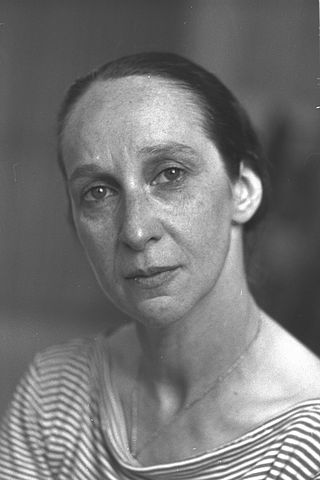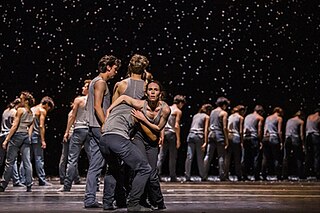Related Research Articles

Martha Graham was an American modern dancer and choreographer, whose style, the Graham technique, reshaped American dance and is still taught worldwide.

Anna Sokolow was an American dancer and choreographer. Sokolow's work is known for its social justice focus and theatricality. Throughout her career, Sokolow supported of the development of modern dance around the world, including in Mexico and Israel.

Lar Lubovitch is an American choreographer. He founded his own dance company, the Lar Lubovitch Dance Company in 1968. Based in New York City, the company has performed in all 50 American states as well as in more than 30 countries. As of 2005, he had choreographed more than 100 dances for the company. In addition to the company, Lubovitch has also done creative work in ballet, ice-skating venues, and musical theater, notably Into the Woods. He has played a key role in raising funds to fight AIDS.

Appalachian Spring is an American ballet created by the choreographer Martha Graham and the composer Aaron Copland, later arranged as an orchestral work. Commissioned by Elizabeth Sprague Coolidge, Copland composed the ballet music for Graham; the original choreography was by Graham, with costumes by Edythe Gilfond and sets by Isamu Noguchi. The ballet was well received at the 1944 premiere, earning Copland the Pulitzer Prize for Music during its 1945 United States tour. The orchestral suite composed in 1945 was played that year by many symphony orchestras; the suite is among Copland's best-known works, and the ballet remains essential in the Martha Graham Dance Company repertoire.

The Batsheva Dance Company is a renowned dance company based in Tel Aviv, Israel. It was founded by Martha Graham and Baroness Batsheva de Rothschild in 1964.

Episodes is a ballet choreographed by Martha Graham and George Balanchine, to compositions by Anton Webern. The ballet was a co-production between the Martha Graham Dance Company and Balanchine's New York City Ballet (NYCB). Though it was conceived to be a collaboration between Graham and Balanchine, leading choreographers in modern dance and neoclassical ballet respectively, they ultimately worked separately on the ballet's two halves. Episodes I was choreographed by Graham, for dancers from her company and four NYCB members, and depicts Mary, Queen of Scots remembering the events in her life before her execution. Episodes II, by Balanchine, is completely plotless, and made for members of the NYCB and Graham dancer Paul Taylor, who originated a solo. The ballet uses all seven orchestral compositions by Webern.
Sallie Wilson was a ballerina who appeared with New York City Ballet where she danced opposite Martha Graham in the premiere of Graham and George Balanchine's collaboration at NYCB, Episodes in May, 1959, and subsequently with American Ballet Theatre, where she was associated with several ballets created by Antony Tudor. In 1966, she achieved a triumph as Hagar in ABT's revival of Tudor's ballet Pillar of Fire, set to the music of Arnold Schoenberg's Transfigured Night. The ballet is loosely based on the poem that inspired the Schoenberg piece rather than the Biblical story of Hagar.

Paul Belville Taylor Jr. was an American dancer and choreographer. He was one of the last living members of the third generation of America's modern dance artists. He founded the Paul Taylor Dance Company in 1954 in New York City.
The Martha Graham Dance Company, founded by Martha Graham in 1926, is both the oldest dance company in the United States and the oldest integrated dance company. The company is critically acclaimed in the artistic world and has been recognized as "one of the great dance companies of the world" by the New York Times and as "one of the seven wonders of the artistic universe" by the Washington Post.
Cave of the Heart is a one-act ballet choreographed by Martha Graham to music by Samuel Barber. It was first performed on May 10, 1946, with the title Serpent Heart, at the second annual Festival of Contemporary American Music in the McMillin Theater of Columbia University. Serpent Heart was commissioned by the festival sponsor, The Alice M. Ditson Fund.
Deaths and Entrances is a ballet choreographed by Martha Graham performed to music by Hunter Johnson. Arch Lauterer created the original set; Edythe Gilfond designed the costumes. The ballet was well-received from the first performance despite being labeled as one of Graham's most personal, least accessible works. Oscar de la Renta created new costumes for the ballet's 2005 revival. The piece premiered on July 18, 1943, at Bennington College in Bennington, Vermont. The first performance was an informal preview for which the dancers wore practice clothes although the set was in place.
Primitive Mysteries is a modern dance work choreographed by Martha Graham to music by Louis Horst. Graham also designed the original costumes. The piece premiered on February 2, 1931 at the Craig Theatre in New York City. From the first performance, critics hailed the ballet as a masterpiece and acknowledged Graham's rising role as a major force in American dance.
Punch and the Judy is a comic ballet about marital discord choreographed by Martha Graham to music by Robert McBride. Arch Lauterer designed the set, Charlotte Trowbridge, the costumes. Edward Gordon Craig provided text for the narrated portions. The piece premiered on August 10, 1941, at the Bennington College Theatre in Bennington, Vermont.
Imagined Wing is a ballet choreographed by Martha Graham to Jeux de Printemps by composer Darius Milhaud. The piece was first presented on October 30, 1944, in the Elizabeth Sprague Coolidge Auditorium at the Library of Congress, Washington, D.C. Costumes were designed by Edythe Gilfond; the set was created by Isamu Noguchi. Elizabeth Sprague Coolidge commissioned the work, along with two other Graham dances, and musical scores for all three dances. Also on the program were Mirror Before Me set to music by Paul Hindemith and Appalachian Spring performed to music by Aaron Copland. Imagined Wing's initial showing was also its last. Following tepid reviews, the piece was never performed again.
El Penitente is a modern dance work by Martha Graham performed to music by Louis Horst. It premiered on August 11, 1940, at the Bennington College Theater, Bennington, Vermont, with costumes by Edythe Gilfond and a set by Arch Lauterer. Isamu Noguchi later redesigned the set and created a new mask.
Land Be Bright is a modern dance work choreographed by Martha Graham to music by Arthur Kreutz with a set and costumes by Charlotte Trowbridge. The unabashedly patriotic piece premiered on March 14, 1942, at Chicago's Civic Opera House. The original cast included Graham and members of the Martha Graham Dance Company.
Columbiad is a solo modern dance choreographed by Martha Graham to music by Louis Horst. Edythe Gilfond designed the costume; Philip Stapp created the set. The ballet premiered on December 27, 1939, at the St. James Theatre in New York City. Columbiad's debut was part of an event called the Holiday Dance Festival, which included four additional works by Graham and pieces by the American Ballet Caravan, Carmalita Maracci and Dance Group, and Korean modern dancer Sai Shoki.
Frontier is a solo dance choreographed by Martha Graham to music by Louis Horst. The set was designed by Isamu Noguchi; Graham created the costume. The work began as an ensemble piece, Perspectives: Frontier and Marching Song also known as Frontiers and Frontier. The ballet's Marching Song portion was set to music by Lehman Engle. The work premiered on April 28, 1935, at the Guild Theatre in New York City. By the end of 1935, Graham was performing Frontier exclusively as a solo. The piece was the first of her works to explore American identity through an archetypal character.
Deep Song, a solo modern dance by Martha Graham, premiered on December 19, 1937, at the Guild Theatre in New York City. Performed to music by Henry Cowell, the piece was the second work created by Graham in response to the Spanish Civil War. The first, Immediate Tragedy, was introduced in 1937.

Flight Pattern is a contemporary ballet choreographed by Crystal Pite, set to the first movement of Henryk Górecki's Symphony No.3. It premiered at the Royal Opera House, London, on 16 March 2017, making Pite the first woman to choreograph for the Royal Ballet's main stage in 18 years. The ballet won the Laurence Olivier Award for Best New Dance Production in 2018.
References
- ↑ "American Document (Ballet choreographed by Martha Graham)". Library of Congress, Washington, D.C. 20540 USA. Retrieved 2022-10-14.
- 1 2 3 Kisselgoff, Anna (1989-10-05). "Review/Dance; Graham Reinvents Her 'American Document'". The New York Times. ISSN 0362-4331 . Retrieved 2022-10-14.
- 1 2 3 Anderson, Jack (1989-10-01). "DANCE; Words of Beauty And Terror Inform A Graham Classic". The New York Times. ISSN 0362-4331 . Retrieved 2022-10-14.
- 1 2 3 4 5 6 Dance Libretto, American Document, by Martha Graham,Theatre Arts Monthly, September 1942
- ↑ Dance Gives Historic Significance, New York World Telegram, October 10, 1938 http://memory.loc.gov/diglib/ihas/loc.natlib.ihas.200154057/pageturner.html
- 1 2 3 4 Maureen Needham Costonis, Martha Graham's American Document: A Minstrel Show in Modern Dance Dress, American Music, Vol. 9, No. 3, University of Illinois Press, Autumn 1991, p.
- 1 2 "An American Document". Library of Congress, Washington, D.C. 20540 USA. Retrieved 2022-10-14.
- ↑ Susan Manning, Modern Dance, Negro Dance: Race in Motion, University of Minnesota Press, p. 136
- ↑ Stuart Hodes, Part Real, Part Dream: Dancing with Martha Graham, Concord ePress, 3rd edition, August 2011, location 2067
- ↑ Political Dance Project, Martha Graham Dance Company, http://marthagraham.org/the-martha-graham-dance-company/current-projects/#political Archived 2015-12-29 at the Wayback Machine
- ↑ "Dancers Lauded for Universality". Library of Congress, Washington, D.C. 20540 USA. Retrieved 2022-10-14.
- 1 2 Gervaise Butler, American Document Re-reviewed, The Dance Observer, November 1938 http://lcweb2.loc.gov/natlib/ihas/service/graham.1/200154015/200154015.pdf
- ↑ "The Dance". Library of Congress, Washington, D.C. 20540 USA. Retrieved 2022-10-14.
- ↑ Helen Thomas Dance, Modernity, and Culture: Explorations in the Sociology of Dance, Psychology Press, 1995 p. 115
- ↑ "Martha Graham Revivals Are Long on Pageantry, Short on Real Movement". Christian Science Monitor. 1989-11-03. ISSN 0882-7729 . Retrieved 2022-10-14.
- ↑ Nancy Goldner, Martha Graham's Troupe In N.Y., The Enquirer (Philadelphia, Pennsylvania), October 06, 1989
- ↑ Star-Ledger, Robert Johnson | For The (2010-06-12). "Martha Graham Dance Company re-creates Depression-era works". nj. Retrieved 2022-10-14.